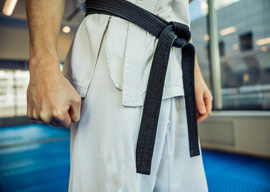
September 17, 2016

Source: Bigstock
I’m jittery and fragile but free of plaster and in the dojo, slowly turning lean and muscular. Never listen to your doctor, is my message. Instead of two months in a cast I spent only five weeks, and I’ve just finished a brutal three-day course of karate with both the leg and elbow still intact. Yippee!
The message was loud and clear. If you’re drinking vodka at 4:30 a.m., don’t lean backward while sitting on a ledge. When the doctors sew you up and place you in a cast, don’t listen to them, take it off early. You have nothing to lose but the plaster. And the moment you’re free, get back to the dojo.
It was back in 1964, while still on the tennis circuit, that I saw something strange advertised outside an auditorium in Cannes. Two people dressed in white pajamas kicking at each other. I went in and saw two Japanese men doing things I had never seen humans do before, and showing great humility toward each other and toward us, the audience. They avoided outward displays of emotion, a fact that separated them from other athletes I’d seen and met. These were martial artists, and I signed up for life. Fifty-two years later I’m still at it.
Committing to the way of karate has not always been easy. There are too many con martial artists teaching the “easy” way to high rank. Yet there is no easy way, just the Japanese way. Ironically, it was an Englishman, Richard Amos, who finally showed me the right path as far as the physical side of karate is concerned. I was always very strong mentally, and with Richard’s help—bingo!—I now sometimes find myself sparring with men fifty years younger and do not suffer unpleasant surprises. The Amos way (stay relaxed and tense up only on contact) works miracles. And it certainly looks good. Karate is like ballet. One can tell a bum from a star after only one move. Mind you, I could be fooling myself. When young karatekas see white hair, perhaps they pull their punches, but I don’t think so. Maybe in Japan, where the oldies are respected—but over here, an oldie means a pushover, even in the dojo.
Throughout my youth, sport was all I did. Tennis, polo, boxing, skiing. Wrestling stopped after university, as there were no country clubs with beautiful young women following the action on the mat. Here’s a tip: If you see a man with cauliflower ears, say please and smile. What polo taught me was that a lot of rich men who cannot play it well hire people who can, but when the time comes, they are the ones who pick up the trophy. Tennis also taught me: to make excuses and think even after getting two bagels that you’re still better than the guy who administered them. Not so in the martial-arts business. I’ve competed in countless karate and judo tournaments, and the only thing I remember is the shots I’ve taken by someone I had defeated. Go figure, as they used to say before Brooklyn was overrun by yuppies.
They say that karate is a daily practice for life. Perhaps. At least it is for people like Richard Amos, who polish the tools of their trade daily. For myself it is a release from other demons like drink and women. A fighting spirit is the most important gift a karateka can wish for. A beautiful technique is great, but without a fighting spirit it goes to waste. My second teacher, Mister Enoeda, a samurai’s son, used the mysterious Japanese ways to tell me that I had done something well. “I hate hippies,” he used to say. (Back in the ’60s I hated hippies almost as much as I hated commies.)
Japanese teachers like Enoeda Sensei exuded strength and confidence. Everything he did was grand, massive, and loaded with hidden meanings. Or so we thought. He managed in no time to whip away any arrogance. We bowed and bowed, and bowed some more. This was fifty years ago. The Americans have made sure that nothing like that exists nowadays. We are, after all, equals, and Japanese humility does not fit with self-esteem. I say it’s total bullshit; that’s why we now see a totally phony sport like tae kwon do in the Olympics. These so-called martial artists wave their front foot in their opponent’s face—a wave they learned from watching the Queen wave from her carriage—and their hand is raised in victory by a phony judge my grandson Taki can take out in a minute.
The Koreans bribed the IOC to make a phony imitation of karate into an Olympic sport. And why not? The IOC is as bent as FIFA, and was considering doing away with Greco-Roman wrestling in the Games. The oldest sport in the world was about to be banned by the Olympic Committee for not being popular enough. A shit by the name of Samaranch had proposed it. His old man had done away with traditional white in judo in order to please the TV sharks. I say do away with all those ridiculous biking events and just have an old-fashioned bike race. And bring back pankration, a combination of boxing and wrestling, whose first-ever winner in 776 BC died the moment his opponent had surrendered. (It beats watching rhythmic swimming.)
I’m off to Sicily for Dame Vivien’s four-day blast, and I hope not to be the youngest man there. Otherwise, oss, which is the traditional way of greeting in karate.